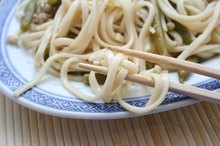What does fact checked mean?
At Healthfully, we strive to deliver objective content that is accurate and up-to-date. Our team periodically reviews articles in order to ensure content quality. The sources cited below consist of evidence from peer-reviewed journals, prominent medical organizations, academic associations, and government data.
The information contained on this site is for informational purposes only, and should not be used as a substitute for the advice of a professional health care provider. Please check with the appropriate physician regarding health questions and concerns. Although we strive to deliver accurate and up-to-date information, no guarantee to that effect is made.
Shanghai Noodles Nutrition Information
The Shanghai noodle is a fresh, thick, egg and wheat noodle 1. It is most often used in Chinese stir fries or soups. As an egg-based noodle, it can be higher in fat than other types of noodles. Knowing the nutrition information for the Shanghai noodle can make it easier for you to make adjustments to your diet so it fits into your meal plan.
Tips
Shanghai Noodles has 125 Calories and 6.27 g of Protein per 100 gram serving according to the nutrition facts provided by the USDA Food Composition Database.
Calories
A 1 cup serving of fresh Shanghai noodles contains 180 calories 2. Cooked spaghetti, which can be a substitute for Shanghai noodles, contains 221 calories per 1-cup serving 2. Choosing the lower-calorie food option can help you save calories overall and aid in weight loss and maintenance.
Fat and Cholesterol
Udon Noodles Nutrition
Learn More
The one significant difference between Shanghai noodles and spaghetti noodles is the fat content. A 1-cup serving of Shanghai noodles contains 6 g of total fat, 1 g of saturated fat and 13 mg of cholesterol. By comparison, a 1-cup serving of cooked spaghetti contains 1 g of total fat, 0.2 g of saturated fat and 0 mg of cholesterol. Fat is a necessary nutrient, but you should limit your intake of total fat to 20 to 35 percent of calories, saturated fat to less than 10 percent of calories and cholesterol to less than 300 mg a day.
- The one significant difference between Shanghai noodles and spaghetti noodles is the fat content.
- By comparison, a 1-cup serving of cooked spaghetti contains 1 g of total fat, 0.2 g of saturated fat and 0 mg of cholesterol.
Carbohydrates
Most of the calories in the Shanghai noodles comes from carbohydrates 2. A 1-cup serving contains 23 g of carbohydrates and 2 g of fiber. Carbohydrates should provide most of your calories, acting as your body's preferred source of energy. You should get 45 to 65 percent of your calories from carbohydrates. Although not a significant source of fiber, Shanghai noodles can help you get closer to meeting your dietary needs. Fiber offers a number of health benefits, including appetite control, improved bowel movements and can help reduce cholesterol levels. Adult women need 21 to 25 g of fiber a day, and adult men need 30 to 38 g of fiber a day.
- Most of the calories in the Shanghai noodles comes from carbohydrates 2.
- Although not a significant source of fiber, Shanghai noodles can help you get closer to meeting your dietary needs.
Protein
Nutritional Information of Fried Crispy Chow Mein Noodles
Learn More
Shanghai noodles are also a good source of protein 12. A 1-cup serving contains 9 g. Women need about 46 g a day, and men need 56 g. One serving of the Shanghai noodles meets about 20 percent of your daily protein needs.
Sodium
In addition to being higher in fat than the spaghetti noodle, the Shanghai noodle is also higher in sodium. A 1-cup serving of Shanghai noodles contains 240 mg of sodium, versus 1 mg of sodium in 1-cup of cooked spaghetti 2. High intakes of sodium can increase your risk of developing hypertension, or high blood pressure. Monitoring your intake can help you keep your levels in check. Try to limit your daily intake to less than 2,300 mg a day.
- In addition to being higher in fat than the spaghetti noodle, the Shanghai noodle is also higher in sodium.
- High intakes of sodium can increase your risk of developing hypertension, or high blood pressure.
Related Articles
References
- Cook's Thesaurus; Asian Wheat Noodles: Shanghai Noodles; Lori Alden, 2005
- My Fitness Pal: Calories in Shanghai Noodles
- USDA: Nutrient Database: Spaghetti, Cooked, Enriched, Without Added Salt
- U.S. Department of Agriculture: Dietary Guidelines for Americans, 2010: Foods and Food Components to Reduce
- U.S. Department of Agriculture: Dietary Guidelines for Americans, 2010: Balancing Calories to Manage Weight
- MayoClinic.com: Dietary Fiber: Essential For a Healthy Diet; November 2009
- Tuck C, Ly E, Bogatyrev A, et al. Fermentable short chain carbohydrate (FODMAP) content of common plant-based foods and processed foods suitable for vegetarian- and vegan-based eating patterns. J Hum Nutr Diet. 2018;31(3):422-435. doi:10.1111/jhn.12546
- Cherry P, O'hara C, Magee PJ, Mcsorley EM, Allsopp PJ. Risks and benefits of consuming edible seaweeds. Nutr Rev. 2019;77(5):307-329. doi:10.1093%2Fnutrit%2Fnuy066
- Pehrsson PR, Patterson KY, Spungen JH, et al. Iodine in food- and dietary supplement-composition databases. Am J Clin Nutr. 2016;104 Suppl 3:868S-76S. doi:10.3945%2Fajcn.115.110064
- Barton A, Mclean B. An unusual case of peripheral neuropathy possibly due to arsenic toxicity secondary to excessive intake of dietary supplements. Ann Clin Biochem. 2013;50(Pt 5):496-500. doi:10.1177/0004563212473276
- Ho HVT, Jovanovski E, Zurbau A, et al. A systematic review and meta-analysis of randomized controlled trials of the effect of konjac glucomannan, a viscous soluble fiber, on LDL cholesterol and the new lipid targets non-HDL cholesterol and apolipoprotein B. Am J Clin Nutr. 2017;105(5):1239-1247. doi:10.3945/ajcn.116.142158
- Sood N, Baker WL, Coleman CI. Effect of glucomannan on plasma lipid and glucose concentrations, body weight, and blood pressure: systematic review and meta-analysis. Am J Clin Nutr. 2008 Oct;88(4):1167-75.
Writer Bio
Jill Corleone is a registered dietitian and health coach who has been writing and lecturing on diet and health for more than 15 years. Her work has been featured on the Huffington Post, Diabetes Self-Management and in the book "Noninvasive Mechanical Ventilation," edited by John R. Bach, M.D. Corleone holds a Bachelor of Science in nutrition.









